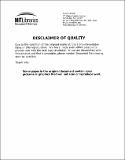| dc.contributor.advisor | Ioannis V. Yannas. | en_US |
| dc.contributor.author | Esaki, Roy Kuniaki, 1982- | en_US |
| dc.contributor.other | Massachusetts Institute of Technology. Dept. of Mechanical Engineering. | en_US |
| dc.date.accessioned | 2006-05-15T20:32:25Z | |
| dc.date.available | 2006-05-15T20:32:25Z | |
| dc.date.copyright | 2004 | en_US |
| dc.date.issued | 2004 | en_US |
| dc.identifier.uri | http://hdl.handle.net/1721.1/32819 | |
| dc.description | Thesis (S.B.)--Massachusetts Institute of Technology, Dept. of Mechanical Engineering, 2004. | en_US |
| dc.description | Includes bibliographical references (p. 45-46). | en_US |
| dc.description.abstract | The treatment of renal trauma can involve the surgical removal of part of a patient's kidney, which leads to scarring, distortion of the renal architecture, and potentially renal insufficiency. Current research suggests that the implantation of collagen-glycosaminoglycan (GAG) extra-cellular matrices after traumatic renal injury prevents contraction, decreases scarring, and may ultimately induce the regeneration of functional renal tissues after injury. The goal of the current study was to develop a new surgical model to study the effects of the matrices on the healing of traumatic renal wounds. Four hemispherical, reproducible wounds were created in the cortex of the left kidney of 20 adult male rats (Rattus norvegicu). Three wounds were each filled with one of three types of matrices, while the fourth remained empty to serve as a control. Four weeks post-operatively, the animals were sacrificed and kidneys were processed by standard histological methods. All animals tolerated the procedure well, and 16 kidneys were included in the final analysis. After four weeks of healing, contraction had occurred in all of the wounds, and a lacuna, a crater-like depression with a raised lip around the perimeter, had formed around the wound site. One of the matrices, with an average pore diameter of 182 [micro]m, decreased the lacuna area by 37% (p=0.006) and the wound area by 26% (p=0.003), but did not significantly affect collagen deposition One of the other matrices, with an average pore diameter of 101 pm, significantly reduced the lacuna area by 43% (p=0.005) and the wound area by 41% (p=0.009) as compared to the untreated control. This matrix also decreased the extent of collagen deposition by 42% (p=0.04); this represents a | en_US |
| dc.description.abstract | (cont.) reduction in the formation of fibrotic tissue, which is a highly desirable objective with respect to the goal of achieving regeneration of functional tissue. These results demonstrate that such collagen-GAG matrices affect wound contraction, and possibly tissue regeneration, although the exact mechanisms could not be determined in this study. A finite element analysis, modeling the geometry of wound closure using data from the alpha-smooth muscle actin stains, should be conducted in a future study to elucidate the healing mechanism, and to allow the present data regarding the effect of the matrix on wound geometry to be better interpreted. | en_US |
| dc.description.statementofresponsibility | by Roy Kuniaki Esaki. | en_US |
| dc.format.extent | 46 p. | en_US |
| dc.format.extent | 2285027 bytes | |
| dc.format.extent | 2285389 bytes | |
| dc.format.mimetype | application/pdf | |
| dc.format.mimetype | application/pdf | |
| dc.language.iso | eng | en_US |
| dc.publisher | Massachusetts Institute of Technology | en_US |
| dc.rights | M.I.T. theses are protected by copyright. They may be viewed from this source for any purpose, but reproduction or distribution in any format is prohibited without written permission. See provided URL for inquiries about permission. | en_US |
| dc.rights.uri | http://dspace.mit.edu/handle/1721.1/7582 | |
| dc.subject | Mechanical Engineering. | en_US |
| dc.title | A new surgical model or studying the healing response of renal tissue in the presence of collagen-glycosaminoglycan matrices | en_US |
| dc.type | Thesis | en_US |
| dc.description.degree | S.B. | en_US |
| dc.contributor.department | Massachusetts Institute of Technology. Department of Mechanical Engineering | |
| dc.identifier.oclc | 57615090 | en_US |
